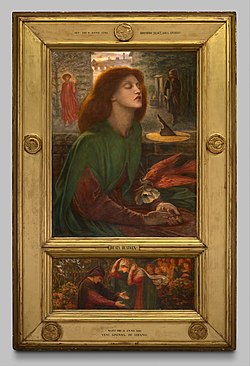Loading AI tools
Painting by Dante Gabriel Rossetti From Wikipedia, the free encyclopedia
Beata Beatrix is a painting completed in several versions by Pre-Raphaelite artist Dante Gabriel Rossetti. The painting depicts Beatrice Portinari from Dante Alighieri's 1294 poem La Vita Nuova at the moment of her death. The first version is oil on canvas completed in 1870.
| Beata Beatrix | |
|---|---|
 | |
| Artist | Dante Gabriel Rossetti |
| Year | c. 1864–1870 |
| Medium | Oil on canvas |
| Dimensions | 86.4 cm × 66 cm (34 in × 26 in) |
| Location | Tate Britain, London |
| Beata Beatrix | |
|---|---|
 | |
| Artist | Dante Gabriel Rossetti |
| Year | c. 1871–1872 |
| Medium | Oil on canvas |
| Dimensions | 87.5 cm × 69.3 cm (34 7/16 in × 27 1/4 in); [predella: 26.5 cm × 69.2 cm]. |
| Location | Art Institute of Chicago, Chicago |
The painting's title in English translates to Blessed Beatrice. La Vita Nuova had been a story that Rossetti had found of interest from childhood and he had begun work translating it into English in 1845 and published it in his work The Early Italian Poets.[1]
Rossetti modeled Beatrice after his deceased wife and frequent model, Elizabeth Siddal, who died in 1862. The painting was created from the numerous drawings that Rossetti had made of Siddal during their time together.[2] The symbolism in the painting of a red dove, a messenger of love, relates back to Rossetti's love for Siddal with the white poppy representing laudanum and the means of her death.[3] Several of Siddal's friends found the painting to bear little resemblance to the drawings of her—the facial features were harder and the neck is out of proportion. Beata Beatrix is one of Rossetti's most recognized works and has caused Siddal's name to be frequently linked with Dante Alighieri's Beatrice.[4]
In an 1873 letter to his friend William Morris, Rossetti said he intended the painting "not as a representation of the incident of the death of Beatrice, but as an ideal of the subject, symbolized by a trance or sudden spiritual transfiguration."[5]
This first painting is on display in the Tate Britain. It was a gift in memory of Francis, Baron Mount-Temple by his wife, Georgiana in 1889.[3]
Rossetti was commissioned by William Graham to paint for him a version of Beata Beatrix, which Rossetti at first resisted. After stopping and starting the work, he grew to enjoy revisiting the theme, and altered the suffusion of light from the original, increasing background definition, and perhaps the idealization of the subject.[6] This oil-on-canvas painting, dated 1871–1872, is in the main slightly larger than the original and adds a predella (bottom panel) depicting Dante Alighieri and Beatrice meeting in paradise, the whole set within a frame designed by Rossetti. Gifted by Charles L. Hutchinson in the 1920s, it is on display at the Art Institute of Chicago.[7]
Several other renditions were made by Rossetti of Beata Beatrix—a watercolor, a chalk drawing and another oil painting that was begun in 1877. The last painting was still unfinished at the time of his death. His lifelong friend, Ford Madox Brown, completed it. In this painting, in contrast to the original, the bird flying towards Beatrice is a white dove holding red poppies in its beak.[4] This painting is in Birmingham Museum and Art Gallery, England.[8] An 1880 oil on canvas version is in the National Galleries of Scotland.[9]

Seamless Wikipedia browsing. On steroids.
Every time you click a link to Wikipedia, Wiktionary or Wikiquote in your browser's search results, it will show the modern Wikiwand interface.
Wikiwand extension is a five stars, simple, with minimum permission required to keep your browsing private, safe and transparent.